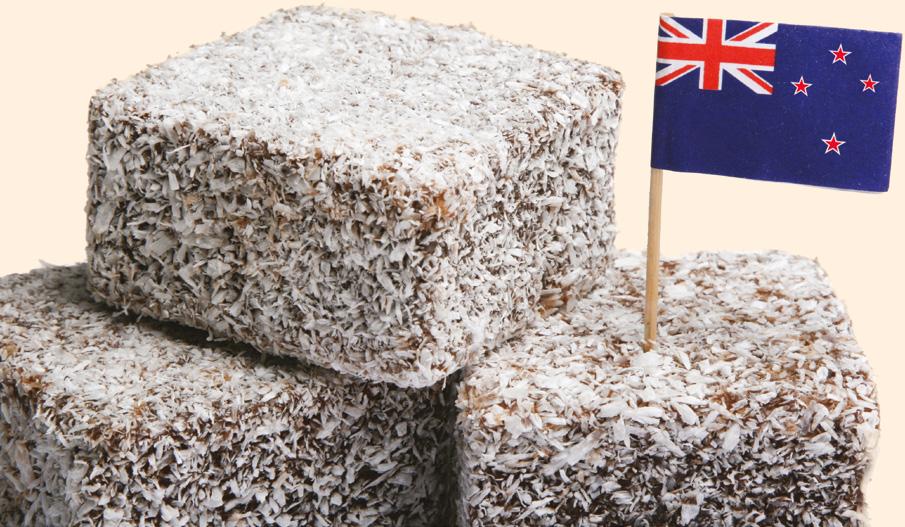
8 minute read
The science and psychology of taste
from Segment magazine 2
Donna Chisholm looks at what’s behind the development of novel food products and what psychology, sensory and consumer science can tell us about balancing novelty, popularity and value in new products.
Within hours of Bluebird® announcing that its new Kiwi Favourites™ chips range featured a lamington flavour, social media erupted in collective disgust. The chocolate and coconut-coated cakes our mums used to make were fine for afternoon tea, but potato chips they were not. The kindest assessment on Twitter, after “WTAF?” was that lamington crisps were an abomination.
Advertisement
The day after the launch in late July, TV1 Breakfast host John Campbell proclaimed lamington chips were, “staggeringly bad. You’d have to be really stoned to enjoy that chip.” That night, Seven Sharp sent co-host Jeremy Wells to interview staff at the Wiri factory that spawned this dietary demon. In the Bluebird boardroom, meanwhile, there were probably high-fives all round. One bag of chips? $2.20. Five minutes’ free advertising on primetime television? Priceless.
The new flavour, one of four which included paua fritters, cheese and onion toastie, and Sunday roast, was least surprising to consumer research experts who recognised the scientific method in Bluebird’s apparent madness. Their research suggests the combination of attention-grabbing weirdness and the comfort of tradition can be a winning formula.
“The chips — and the timing of them — are really interesting given the whole COVID-19 experience,” says Plant & Food Research psychologist Dr Denise Conroy. “This is very much a nostalgia thing but it is not just about our childhood — it is very New Zealand. We have always seen that in categories that don’t cost a lot of money, people do novelty-seek. It’s not a great deal of money to invest so if we’re disappointed it’s not as if we’ve bought a $75,000 car and we’re kicking ourselves.”

“We’ll start to see many more New Zealand products coming through because of COVID-19. We are cut off at the moment, we are on our own in the world and we’ve done really well. There’s a health halo around New Zealand food anyway in terms of our fresh fruit, vegetables, meat and fish, but that’s just increased hugely because of our track record with COVID-19. This is a fantastic story and we should be exploiting it to our absolute advantage.”
Conroy herself is not that adventurous when it comes to new flavours, but says she’d consider serving them as a novelty, to experiment with friends. That’s just the market the manufacturers are likely to be aiming for, according to Dr Sara Jaeger, Plant & Food Research’s Team Leader of Sensory and Consumer Science. “You see limited-time offers of weird and wacky flavour combinations in all sorts of product categories now. It’s an almost global phenomenon and it also has something to do with social media, where people can take pictures and say, ‘Look what I ate; isn’t that funny and exciting?’ There is a clear experiential element to it.”

Dr Denise Conroy, Team Leader Stakeholder & Consumer Intelligence.
Jaeger, internationally renowned for her work in sensory food science, has teamed up with another of the world’s foremost researchers, Massachusettsbased Dr Armand Cardello, to examine uniqueness in food products, to understand consumers’ sensory and emotional responses.
One paper they co-authored, published in Food Quality and Preference in 2016, focused on the “explosion” of craft beers, a category that varies greatly in style, quality, ingredients, sensory attributes and brand images. They found that consumers generally regarded the most familiar or traditional beers as “ordinary”, “boring” and “simple”. Although beers described as appealing were found in both the novel and familiar categories, familiar products were deemed more appropriate for “everyday” situations, while novel beers were seen as more fit for special occasions. The more “ordinary” beers also attracted passive emotional responses, such as “dull/bored/ uninspired” but the novelty brews evoked more active emotions, and were more likely to be described as intriguing and complex.
“You are trying to have a product that is liked, but also elicits some excitement,” says Jaeger. “Emotional activation can also be negative and there can be disgust-type responses. For example, oysters can be really polarising, so you are trying to find a product that offers excitement in a positive way while at the same time not being so niche that you are only trying it once for fun.” Some fast-moving consumer goods, such as chips, are probably only ever intended as a short-term gimmick, particularly when they don’t cost a fortune to produce and change out flavours, she says.
Jaeger and Cardello have developed a 31-item Food and Beverage Need for Uniqueness (FBNU) scale to measure consumers’ predilection for unique food and drink and to better understand their behaviour. In a paper on the scale published last year, they said that individuals scoring high on the FBNU scale perceived less difference between novelty foods and drinks and familiar ones, expected to like them more, had more positive emotions toward them, were more willing to eat/drink them, and saw them as more appropriate to use in a wide variety of consumption situations.
Plant & Food Research’s work with producers and manufacturers helps them to move from being very “liking-focused” into broader notions of connecting with the consumer on multiple levels. The importance of recognising a consumer’s emotional response to food, and the crucial role of the social setting in which it’s consumed, has long been recognised, Jaeger says. “Where possibly the change has been is that we are now trying explicitly to connect that emotional aspect directly into the food products and their characteristics.”
While consumer “liking” is critical, it is not the only predictor of how successful a product will be. “We need to better understand consumers’ overall experience. We’re not saying you can ignore what a product tastes like, because if it doesn’t taste good the chance it would be consumed repeatedly is very low, but there are products that taste nice that are not particularly successful, so what else is it that we need to understand about people’s experience of these products that we can tap into? That’s where the emotional space has some traction.”
Dr John Prescott — former director of the University of Otago’s Sensory Science Research Centre and now a British-based taste consultant — notes in his book Taste Matters: Why we like the food we do that some
top chefs, such as the innovative Heston Blumenthal of Michelin-starred British restaurant The Fat Duck, capitalise on “a multisensory immersion in sights, sounds, odours, textures and tastes, with contributions from memories and emotions. One clear aim is hedonic, but it is at least partly pleasure based in memory, the evoking of warm feelings of nostalgia.”
Even the description of a dish can alter a consumer’s experience of it. In one study Prescott quotes, participants ate an identical dish but some were told it was cold smoked salmon mousse, others that it was smoked salmon ice cream. Those who thought they were eating mousse were markedly more positive about the dish — fish-flavoured ice cream, however, was more difficult to make sense of. In the book’s foreword, Blumenthal writes that discussions with scientists such as Prescott have had a powerful influence on the direction his cooking has taken.

Weird flavour combinations, such as bacon and egg ice cream offered at The Fat Duck, seem to excite novelty-seeking consumers, says Jaeger. However, her research indicates there’s a small but not insignificant group — around 20–25% of people — who are moderately to severely food neophobic, meaning they’ll try to avoid unfamiliar foods. Although food neophobia typically peaks in toddlers, there are genetic components: identical twins are much more likely to have similar levels of neophobia than non-identical twins. Plant & Food Research can use this information to measure where people sit on that psychological construct and thus better understand their food choices.
The popularity of flavours and flavour combinations is tracked on international databases and many of the innovations that apparently come out of left field, or are marketed as uniquely Kiwi, in fact are not. For example, lamington-flavoured crisps were launched across the ditch in January 2020 by Smith’s, which hyped them as quintessentially Australian, with the taglines, “Strewth what a Beaut” and “Fair dinkum — it’s lamington”.
The powerful influence of branding and description on how consumers experience a product is apparent from the popularity of Whittaker’s chocolates that trade on old Kiwi favourites such as Jelly Tip ice cream and L&P (Lemon & Paeroa) soft drink. Dr Roger Harker, Plant & Food Research's Science Group Leader of Consumer and Product Insights, says consumers in taste tests are good at describing sweetness, bitterness, acidity and texture but struggle to find words for particular flavours.
“I’m sure a Jelly Tip ice cream is a completely different sensory experience to the chocolate, but because they’ve given it a name, the consumer is looking for something that prompts their mind to recognise it, such as the colour palette and jelly texture rather than the flavour. You have to have something in the product to trigger that memory,” says Harker.
Until recently, there was no way of measuring uniqueness or understanding its value. Now scientists use a uniqueness curve to plot novelty against popularity and value. “It’s easy to make something unique that nobody likes, and it’s probably really easy to make something that’s the same as everyone else’s, but you don’t gain much value,” says Harker. “What you are trying to do is be at the top of that curve, for maximum uniqueness for maximum value or liking.”
Will lamington chips top the curve? Not if the Australian experience is anything to go by. On Smith’s Chips Facebook page, they’ve not rated a mention since their launch, and have been superseded since by a string of new flavours. Teriyaki chicken or sizzling beef chips anyone?










